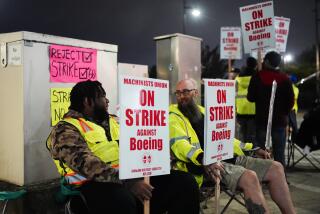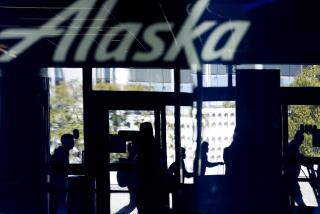Eastern’s Fate Won’t Have Much Effect on Air Travel
WASHINGTON — For the short term, the Eastern Airlines strike has spelled crowded planes, complex travel schedules and a shortage of discount fares for passengers headed for Caribbean cruises and Florida vacations. And those who paid for tickets for canceled Eastern flights generally got nothing for their money.
But eventually, whether Eastern survives or dies, airline service will return to normal. Eastern’s grounded aircraft inevitably will be back in the air, carrying the banner of a revived Eastern or sold to a competitor if Eastern dies. The streamlined airline industry, analysts agree, will tailor its flights to meet the public’s demand.
“If Eastern never flew again,” analyst Edmund S. Greenslet said, its landing slots and planes would be quickly sold, and within six months “the public would not know that Eastern had ever existed.”
But they might wish it still did. As Delta, American and Pan American World Airways grow richer and bigger on the busy routes they now share with Eastern, price competition might suffer. Without Eastern, which carried nearly 7% of the nation’s air traffic last year, other airlines would probably cut back on the discount fares they have been using to woo passengers.
The torrent of speculation about possible buyers for all or part of Eastern’s operations is testimony to the lure of its lucrative markets.
During the first three quarters of last year, Eastern enjoyed big shares of the total air traffic on some heavily traveled routes: New York to Miami, 53%; Boston to Washington, 52%; New York to Boston, 33%; New York to Washington, 32%, and New York to Orlando, Fla., 28%, according to a study prepared for The Times by Yield Data Services of Washington.
Other Airlines Benefit
Since the strike began March 4, Eastern has been able to fly only 10% of its normal daily schedule of 1,040 flights. Each passing week lengthens the odds against Eastern, which declared bankruptcy March 9, returning to full operation under its current ownership. Other carriers are moving into the vacuum left by Eastern’s grounded planes and solidifying their expanded market shares.
Delta, which uses Atlanta as a hub for many of its flights, is a big winner because Eastern also uses Atlanta as a hub. In Boston, Delta and USAir are carrying more passengers. Piedmont is making gains in the cities served by the Charlotte, N.C., hub, another important airport for Eastern. Pan Am’s shuttles from New York to Boston and Washington got a major boost. Trans World has been helped on routes between the Northeast and Florida.
Generally, these airlines lack spare planes and personnel to throw into the breach during the Eastern strike. Instead, their regular flights are more crowded.
The federal government is not worried about the possible demise of Eastern. “There has not been a major disruption for business or recreational travel,” said Bob Marx, spokesman for the Department of Transportation. “Other carriers have been able to fill the gap. We want to keep hands off.”
Domestic routes are almost totally unregulated. With four exceptions, any airline can fly to any airport. “It happens almost daily,” Marx noted. “You pick up the newspaper and see an ad announcing that a carrier will begin service to XYZ cities.”
Holding Back Expansion
The exceptions are four of the nation’s most crowded airports: O’Hare in Chicago, National in Washington, and LaGuardia and Kennedy in New York. For safety reasons, only a limited number of landing slots are available there, and if Eastern goes under, its competitors will have to bid for its landing rights.
Although access to markets is free and easy, other carriers hesitate to make permanent commitments to expand until they know whether Eastern will recover. “Why rip up the current route system to put extra capacity into unsettled Eastern markets,” said Timothy Pettee, an airline analyst with Merrill Lynch.
This prudence has been bad news for those who were caught holding tickets on Eastern when the strike began. “Some people who had been booked on Eastern were left stranded,” noted Helane Becker, an analyst at Shearson Lehman Hutton. “After initial juggling around, other airlines will move to fill the void that is left.”
Some passengers “are frustrated because they can’t get on the exact flight they want,” said Jim Brown, a spokesman for American Airlines, which has added a few flights from New York to Puerto Rico since Eastern’s machinists walked out March 4. “We don’t have the crews and aircraft standing by, and we will not defer scheduled maintenance to accommodate extra flights.”
Pan Am, however, has been able to expand service significantly in a special market, the heavily traveled shuttle corridors between Washington, New York and Boston. They are veritable highways for business executives, government officials, professors and consultants.
“The shuttle is an accordion, able to expand and contract according to demand,” said Jeff Kriendler, vice president for corporate affairs at Pan Am. The airline’s normal shuttle tally is 64 flights daily. Since the Eastern strike began, Pan Am has added as many as 30 extra flights.
To accomplish that, Pan Am has added just one extra plane, a big A-300 airbus. The additional demand is being met by reducing the turnaround time on the ground for aircraft and by having pilots fly extra hours.
“Things are remarkably normal considering that volume has doubled,” Kriendler said.
‘Eastern Has Had It’
Pan Am carried 27,000 people during one frenzied weekend period shortly after the strike began, charging $99 for the Friday flight and $69 on Saturday and Sunday.
“Business executives are flying Pan Am at $99 rather than the Eastern shuttle at $49 because of certainty and reliability,” said Nicholas Glaskowsky, professor of management and transportation at the University of Miami in Coral Gables.
“Eastern as a major carrier has had it, “ he said. “They will never be able to come back to what they were.”
Airline customers do not have strong brand affections. “The only loyalty is to get where you want to go when you want to go,” said Greenslet, the head of ESG Aviation Services, which publishes a monthly review of airline finances and traffic. “Other companies will pick up Eastern’s business, and the customer in the end won’t notice the difference.”
Eastern suffered operating losses of $83 million in last year’s fourth quarter, and its long-range chances of survival seem slim even if the strike is settled. In sharp contrast, its rivals are fat with cash and eager to make their temporary market gains permanent. American had a profit of $181 million in the final quarter, Delta amassed $119 million and United earned $112 million.
These carriers have billions of dollars worth of new, fuel-efficient aircraft scheduled for delivery to their fleets in the next few years. “The rich got richer,” Edward Starkman of the Paine Webber financial firm said in a recent report.
During the current period of uncertainty, while Eastern’s fate remains unsettled and long before new aircraft can be committed to Eastern’s routes by its competitors, consumers will pay more to fly.
The rivals of Eastern, afraid of a public relations backlash, are not raising their regular fares. Instead, they are offering fewer discount fares for travelers who pay well in advance for nonrefundable tickets.
Fast Sell-Outs
Each airline has an elaborate computer program designed to maximize revenue through a careful combination of conventional and discount fares. For a Wednesday evening flight from New York to Chicago that is normally only 25% full, the airline will make ample numbers of discount tickets available.
Now, however, all but a relative handful of the 500,000 people who usually fly Eastern on a given day are trying to crowd onto other airlines. Their flights fill up quickly, making it unnecessary for the airlines to offer large numbers of discount tickets. What cheap seats remain sell out in a hurry.
If Eastern flies again, it would try to recoup its market share with drastic price cuts, such as the $12 shuttle fare that brought out a temporary swarm of passengers for a weekend soon after the strike began.
“Whenever a carrier gets back on its feet after a long hiatus, it will offer big discounts,” a travel agency official said. “That always happens after an airline strike.”
However, Eastern may have been so badly damaged by the bitter strike that even deep discounts will fail to bring back the customers.
“Even a very aggressive pricing policy by Eastern, should it find a way to return to service and try to recover lost passengers, would probably not be met by competitors in very big numbers,” according to the report by Starkman of Paine Webber.
Thus, higher prices seem unavoidable on Eastern’s routes. In an address to corporate travel executives, Greenslet said: “Maybe the only way for you to offset rising travel costs is to own equity positions in airline stocks.”
EASTERN’S TOP MARKETS BEFORE THE STRIKE New York to Miami Eastern: 53.2% Pan American: 24.5% Continental: 9.9% TWA: 7.8% American: 1.1% Boston to Washington Eastern: 52% USAir: 18.1% United: 16.6% Delta: 6.7% Continental: 2.8% New York to Washington Pan American: 34.6% Eastern: 32.4% Continental: 18.4% United: 8.9% TWA: 4.4% New York to Boston Pan American: 33.6% Eastern: 31.5% Continental: 22.8% Piedmont: 4.1% TWA: 3.6% New York to Orlando Eastern: 28.6% Delta: 28.2% Continental: 17.8% TWA: 13.9% Pan American: 3.2% Source: Yield Data Services, Inc.
More to Read
Inside the business of entertainment
The Wide Shot brings you news, analysis and insights on everything from streaming wars to production — and what it all means for the future.
You may occasionally receive promotional content from the Los Angeles Times.










